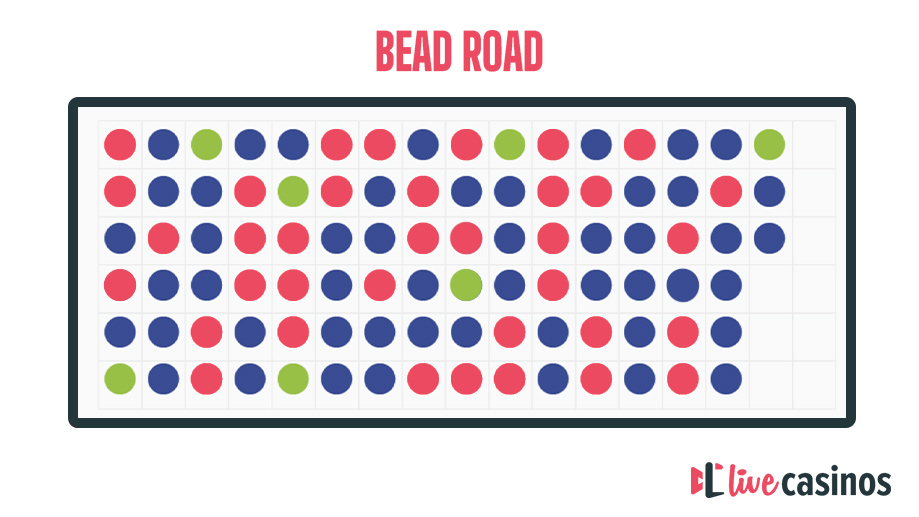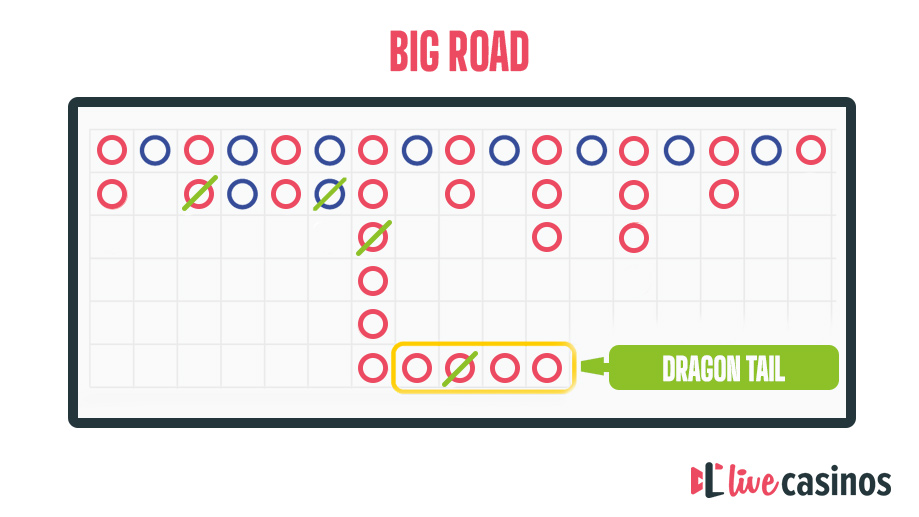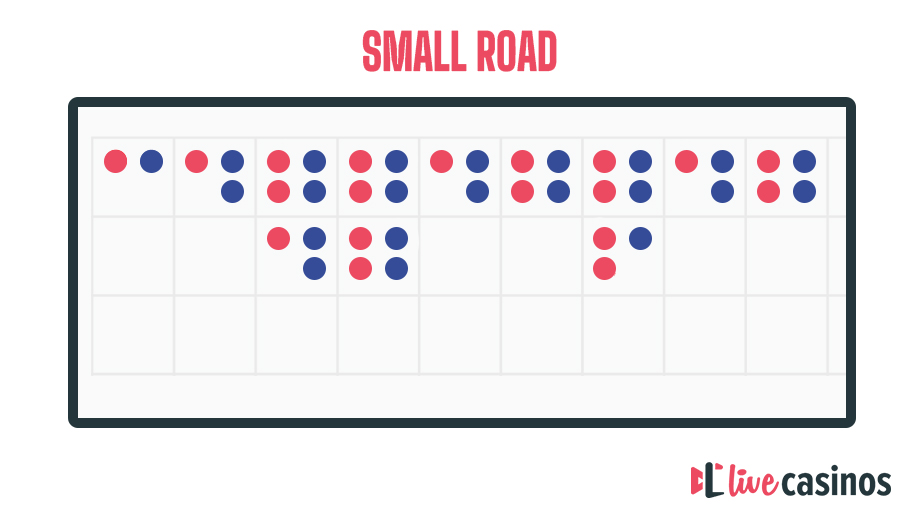Baccarat scoreboards are tools used to track the results of multiple rounds of baccarat, or more accurately Punto Banco.
Most such scoreboards are not just simple histories that list Player/Banker wins or losses. Instead, the tables focus on highlighting patterns, winning streaks, or consecutive identical results.
There are many different types of baccarat scoreboards, such as the Bead Plate, Big Road, Small Road, and the infamously named Cockroach Pig. Each of them focuses on different aspects of the result history. Most of them also offer unique ways of recording results, which is why they can be confusing to read – especially if you’re a newbie.
The purpose of these scoreboards is to inform the player about the current shoe, how it’s progressing, and supposedly what you can expect in future rounds. As such, baccarat scoreboard strategies are quite popular among players, even though these strategies have little basis in maths or statistics.
The image below shows a typical example of a scoreboard called the Bead Road. Unlike most roadmaps, the Bead Road is simply used to record outcomes of rounds – Player wins, Banker wins, and Ties.

Why Are Baccarat Scoreboards Important?
The short answer is that they’re really not all that important.
Most of the assumptions around these roadmaps are either superstitions or logical fallacies, most notably the Gambler’s Fallacy.
The whole idea behind these charts and strategies is to predict future outcomes based on previous results. Unfortunately, this logic is inherently flawed – statistically, the chances of either Player or Banker winning in any round are the same as in any other round. Banker wins 45.8% of the time, while Player wins 44.6% of all rounds. The remaining 9.6% of rounds end in a Tie.
Some players believe that keeping score using roadmaps and charts tells you which cards are still in the shoe, as if you were card counting. However, baccarat isn’t blackjack. No card is inherently better than another due to the basic rules of the game – a 2 has the same chances of being part of a winning hand as a 9.
Moreover, the dealer places cards on the Player and Banker positions by alternating between them. Even if you’re informed about which cards are still in the shoe, that still won’t tell you whether Player or Banker is more likely to win in the future.
Having said all that, gamblers are a famously superstitious bunch. This is especially true among East Asian cultures, where gambling is believed to be closely tied to fate. That’s why some players are quite serious about their scoreboards, believing that winning streaks are indicators of luck going one way or another.
There’s really nothing wrong with believing something like that, and we’re not here to look down on anyone. However, here on LiveCasinos.com, we base our gaming strategies on cold, hard facts: statistics backed by evidence. If nothing else, it’s the only fair and objective way to write gambling strategy guides.
As such, this entire baccarat scoreboard strategy guide comes with one big disclaimer: none of this information can be actually used to increase your chances of winning baccarat or your long-term winnings. However, the scoreboards can still be interesting, and many players are curious about them, so we’ll explain how they work anyway.
The good news is that reading baccarat charts doesn’t really hurt your chances of winning either. As long as you stick to the basic principles of baccarat strategy, you can try and base your predictions on these scoreboards with no real downsides.
Types of Baccarat Scoreboards
As we’ve already mentioned, there are several common types of baccarat scoreboards that can be found in almost any baccarat game.
If you’re playing at a real-life baccarat table, you’ll usually have to fill them out manually. Some casinos and game rooms hand them out as paper tables – especially in Macau and other Asian locales.
Live and online versions of baccarat typically feature them as a part of the game interface. Some games, such as SA Gaming Baccarat, show as many roadmaps as they possibly can. Others simply throw in one or two as part of their in-game result tracking.
Either way, we’ll now go through the most widespread types of baccarat scoreboards. There are definitely more of them out there, but most are derived from the ones we’ll mention below.
Big Road
The Big Road is by far the most common type of baccarat scoreboard. It’s one of the simpler examples of roadmaps, but it also serves as the basis for most other types as well.
Like every scoreboard, it tracks the results of baccarat rounds. Player wins are marked with a blue dot or circle, while Banker wins are marked by red. Ties are marked by a green line through a blue or red circle – more on that later.
Each filled column on this board shows how many consecutive wins have happened for either the Banker or the Player. Entries are only added in the same column if they are the same color as the previous entry. For example, if you’re adding a Blue marker for a Player win, you only add it to the same color if the previous marker was also Blue. If the previous marker is Red, you instead move on to the next column on the right.
The idea is basically to keep track of winning streaks. Each column is one such streak, whether it be a Player or Banker streak. If there is only one marker in a column, it means that no streak occurred.
According to the Big Road scoreboard, Ties do not break streaks. That’s why they’re not marked separately but merely added to the previous marker. If a Tie occurs, it does not break any ongoing streaks. If the following rounds end up with the same result (Player/Banker win) as the round before the Tie, you simply continue marking the same column.
Dragon Tail
The Big Road scoreboard typically only has 6 rows per column. If there are 6 or more consecutive Player/Banker wins, the column “curves” to the right, as you can see in the example below. This is often called a “Dragon Tail.”
The Dragon Tail is significant because it shows a very long streak of similar results, which is a relatively uncommon event. Many players believe that this is a strong indicator that the streak is likely to continue even further: a “hot streak”, as it were.
Players who like to follow scoreboards strongly believe that you should bet on any Player or Banker streak that manages to form a Dragon Tail. The term for this strategy is called “Follow the Dragon.”

Big Eye Boy
The Big Eye Boy scoreboard also focuses on tracking streaks, and its main principles are derived from the Big Road. However, it’s a bit more complicated.
First of all, the Big Eye Boy ignores Natural wins and Ties. If one of these occurs, simply skip the current round and don’t mark anything.
Essentially, the Big Eye Boy is fully derived from the Big Road. The idea is to observe the Big Road and record any emerging patterns or repeating results while ignoring everything else.
The first entry in the Big Eye Boy table is the hand after the first entry in the second column of the Big Road. You skip the first few hands because there is no time to develop a pattern yet.
Then, events are recorded as follows:
- If the hand in question causes a new column in the Big Road, compare the previous two columns in the Big Road. If the two columns are equal in terms of the number of consecutive wins, the table records a red circle. If they are not, then a blue circle is marked.
- If the hand in question has the same outcome as the previous hand, compare the position directly above it. If the two positions are the same (two Banker wins, two Player wins, or two blank spaces), the table marks a red circle. Otherwise, the position is marked as blue.
It’s a bit confusing at first, but the idea of the Big Road is to gauge how “choppy” the current shoe is. Red circles mean that the shoe tends to show streaks of similar results, whether they’re Player or Banker wins. Blue circles mean that the two bets are winning intermittently, implying that the shoe is chaotic and difficult to predict.
Small Road
The next popular baccarat scoreboard is called the Small Road.
The Small Road works exactly like the Big Eye Boy, except it skips the column to the left of the current column in the Big Road. As such, Small Road must wait until the entry after the first entry in the third column of the Big Road. Otherwise, there isn’t enough information to work with.
- If the hand in question causes a new column in the Big Road, then compare the first and third columns to the left of the new column in the Big Road. If they have the same number of markers, record a red circle on the Small Road.
- If the hand in question has the same outcome as the previous hand, compare the two positions to the left of the current round’s position with the one directly above it. If they’re the same (two Banker wins, two Player wins, or two blank spaces), mark the scoreboard with a red circle. Otherwise, mark it with a blue circle.
The Small Road essentially does the same thing as the Big Eye Boy, but with a higher standard for what is considered a streak. Basically, only streaks of 3 or more consecutive identical results are highlighted with red markers. Other results are all marked with blue.

How to Read Baccarat Scoreboards
Now that we know how baccarat scoreboards are recorded, it’s time to consider how to actually interpret the information they present.
Big Road
The basic Big Road scoreboard is the simplest to interpret, so it’s usually what most players stick to.
The longer a certain column is, the longer the winning streak for a particular bet.
Tall columns of blue markers mean that a Player winning streak has occurred. Conversely, a tall column of red markers means that the Banker pile is on a winning streak.
Derived Scoreboards – Big Eye Boy & Small Road
The derived scoreboards are all about recording streaks, whether they’re Player or Banker wins.
In both cases, a red marker means that some sort of streak has occurred. The charts do not indicate whether the streak is made up of Player or Banker wins – merely that a streak has occurred, one way or another.
Conversely, a blue circle means that there is no streak. In other words, a blue marker means that round outcomes are alternating between Player and Banker wins.
In any case, Tie results are not recorded in derived scoreboards – not even in the unlikely event of multiple successive Ties.
- The Big Eye Boy starts recording streaks at 2 wins. A single red marker in a column means that a bet has won twice in a row. Every marker beyond the first signifies a single additional win in that particular streak. For example, 2 red markers mean that either Player or Banker has won 3 times in a row. 3 red markers mean that either Player or Banker has won 4 times in a row, and so on.
- The Small Road works the same way, except that it only records streaks of 3 wins or more. A single red marker in a Small Road column means that either Player or Banker has won 3 consecutive rounds. Two red markers mean that one of these bets has won 4 rounds in a row, and so on.
Common Patterns and Trends Found on Baccarat Scoreboards
As we’ve already explained, most baccarat scoreboard charts are all about recording trends and patterns. If you understand how to record and read them, you probably have a basic understanding of how these trends are displayed.
For the sake of clarity, though, we’ll flip things around. Let’s go through spotable trends and how to recognize them on a baccarat scoreboard.
- Player Streaks: In the Big Road table, Player win streaks are signified by tall columns of blue markers. In derived scoreboards, Player winning streaks are not distinguishable from Banker streaks – both are simply marked with red circles.
- Banker Streaks: Big Road scoreboards mark Banker streaks with tall columns of blue markers. Derived scoreboards make no distinction between Banker and Player successive wins.
- Tie Streaks: Tie results only happen in 9.6% of all rounds, which means streaks of Ties are quite unlikely. Moreover, Tie results return half the stake to all Banker/Player bets. As such, most scoreboards either ignore Ties or don’t count them as a break in a streak. Depending on the type of scoreboard, they’re marked by either a green marker or a green line going through a red or blue marker. Multiple green markers in successive table positions mean that Ties occurred multiple times in a row.









































 Roulette
Roulette
 Blackjack
Blackjack
 Baccarat
Baccarat
 Poker
Poker
 Sic Bo
Sic Bo
 Dragon Tiger
Dragon Tiger
 Game Shows
Game Shows  Top 5 Games
Top 5 Games  See more
See more  Roulette Casinos
Roulette Casinos  Low Limit
Low Limit  High Limit / VIP
High Limit / VIP  Exclusive
Exclusive  How to Play
How to Play  Basic Strategy
Basic Strategy  Top Tips
Top Tips  FAQ
FAQ  Blackjack Casinos
Blackjack Casinos  Baccarat Casinos
Baccarat Casinos  Bonuses
Bonuses  Poker Casinos
Poker Casinos  Game Providers
Game Providers  Sic Bo Casinos
Sic Bo Casinos  Dragon Tiger Casinos
Dragon Tiger Casinos  Credit and Debit Card
Credit and Debit Card  e-Wallet
e-Wallet  Cryptocurrency
Cryptocurrency  Bank and Checks
Bank and Checks  Pay by Phone and SMS
Pay by Phone and SMS  See more
See more  How-To Guides
How-To Guides  Top Lists
Top Lists  In-Depth
In-Depth  Strategy
Strategy  Casino & Games
Casino & Games  Insight
Insight  News
News  Promotions
Promotions 
 Guide to Live Casinos
Guide to Live Casinos  Top 10 Live Casino Tips
Top 10 Live Casino Tips  Studio Locations
Studio Locations  FAQ & Help
FAQ & Help  Meet The Dealers
Meet The Dealers  Our Awards
Our Awards  How We Rate
How We Rate  Responsible Gambling
Responsible Gambling 




























 ENG
ENG 









 Facebook
Facebook
 Pinterest
Pinterest
 Twitter
Twitter
 LinkedIn
LinkedIn
 Copy Link
Copy Link 


















